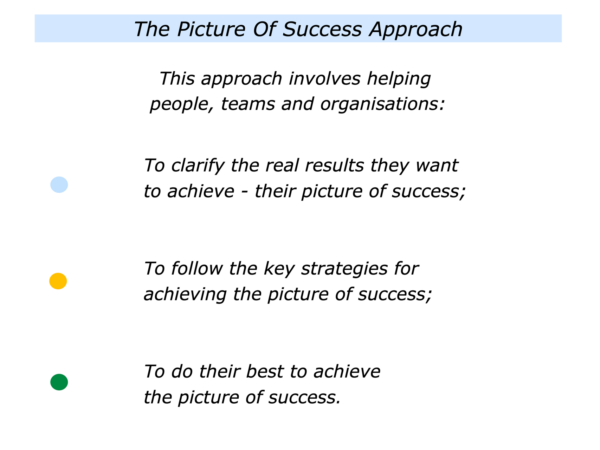
This approach can be used to help individuals, teams and organisations to achieve their goals. It can be used in face-to-face sessions, workshops or remote learning. It encourages people to be focused rather than foggy.
People want success, for example, rather than simply wanting change. Many social movements and therapy programmes focus on change as if that is an end in itself. One of the keys, however, is:
To focus on helping people to
achieve their picture of success.
People are also often more motivated when they see the benefits of achieving a goal. They are then more likely to do their best to achieve the picture of success.
Imagine that you want to follow this approach in your own way. You may be aiming to help a person, team or organisation to achieve their personal or professional goals.
This involves focusing on the following themes. Whatever the situation, you can help people:
To clarify the real results they want to achieve – their picture of success;
To follow the key strategies for achieving their picture of success;
To do their best to achieve their picture of success.
Bearing these things in mind, it can be useful to get some background before moving on to helping people to achieve their aims. This can involve focusing on the following themes.
The Present Situation
What is happening in their world? What may be the challenges they face? What may be the goals they want to achieve? What is the first topic they want to explore? What is actually happening in the situation? Can they give some specific examples?
The Picture Of Success
Looking at the topic they want to explore, what are the real results they want to achieve? What is the picture of success? What would be the benefits of achieving these goals? What would be the specific things that would be happening that would show they have achieved the goals?
The Possible Ways Forward
What are the things they can and can’t control in the situation? Bearing these in mind, what are the possible options for moving forwards? What are the pluses and minuses of each option? Are there any other potential creative solutions?
What is the route they want to follow? What are the key strategies they can follow to give themselves the greatest chance of success? How can they get some quick wins? What else can they do to increase the chances of achieving the picture of success?
When appropriate, the approach also involves you passing on knowledge and practical tools they can use to achieve their goals. You will, of course, do this in your own way.
Looking back, can you think of a situation you followed elements of the picture of success approach? You may have been encouraging a person, facilitating a workshop, leading a team or doing another activity.
How did you clarify the real results they wanted to achieve? How did you clarify the strategies they could follow? How did you pass on knowledge and practical tools they could use?
If you wish, try tackling the exercise on this theme. This invites you to complete the following sentences.
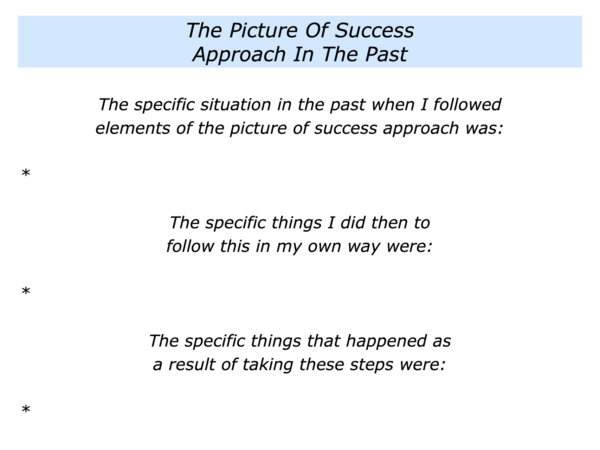
There are many ways to clarify the picture of success. The following pages explore some of these approaches.
The Goals Approach
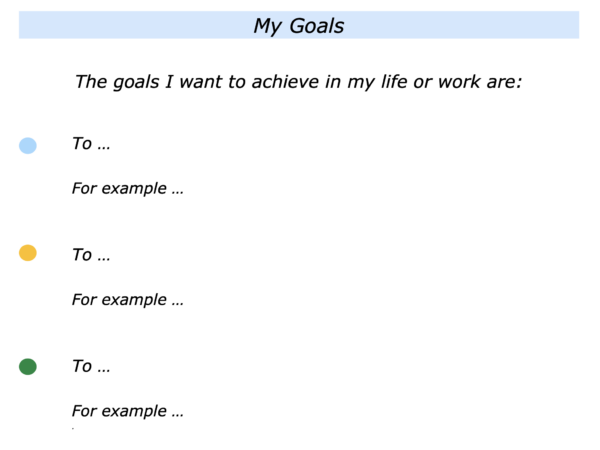
This is one of the most basic approaches to working with people. It focuses on helping them to clarify and achieve their personal or professional goals.
The first time I came across it was when practicing Reality Therapy. This encouraged people to take responsibility for shaping their futures.
There are many ways to use the goals approach. These include variations such as the classic GROW model. This encourages a person to focus on their goals, reality, options and their will to work towards achieving the goals.
Whatever approach is used, these often involve using the keywords What, How and When. Different people use different questions when using this approach. They may, for example, invite somebody to explore the following themes.
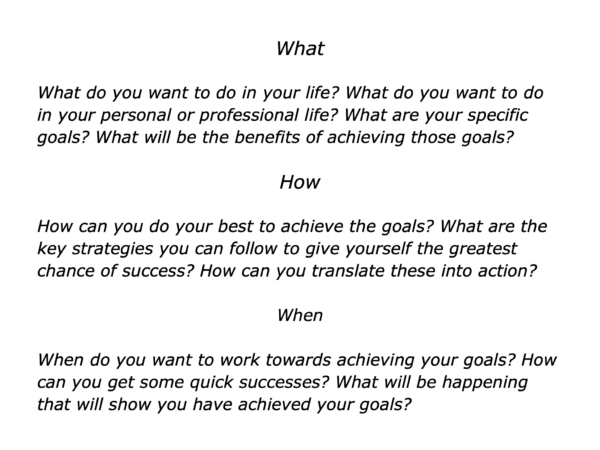
There are many ways to apply this approach. The following pages explore some of the most common ways to help people, teams and organisations to achieve their aims.
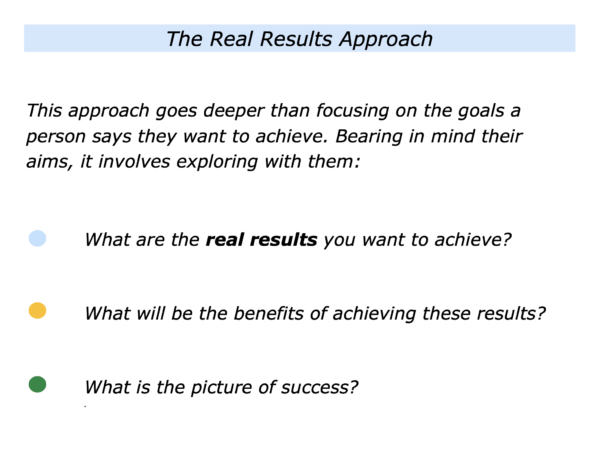
Imagine that somebody has asked for your help in clarifying their aims. Different individuals will want to explore different themes. They may, for example, describe some of the following aims:
I want:
To help our son to pass the exams needed to get to university … To keep progressing in my career … To regain a sense of purpose in my work … To become a marketing director … To change the culture in our company … To fulfil my potential.
Imagine that a person wants to focus on one of their goals. It can be useful to clarify the real what – the real results to achieve.
What does a parent want to achieve, for example, by helping their son to pass exams? Do they want to help them to get into university or to have a satisfying career?
There may be other ways to help their son to have a satisfying career without going to university. They can help them: a) to build on their strengths; b) to do stimulating work; c) to earn a good salary.
What does a person want to achieve by becoming a marketing director? They may want to do strategic marketing work and build an outstanding reputation.
Some marketing directors are able to do this, but some join companies where the CEO sees themselves has the chief marketer. They simply want somebody who is an implementer. The person may be able to find other ways to build a reputation as a strategic marketer.
Imagine that a customer asks you to fix a specific problem. They may already have an idea about what needs to be fixed and how. They may say something along the lines of:
“We want your help in fixing: a) … b) … c) … The things we would like you to do to help fix it are: d) … e) … f) …”
The customer is understandably focusing on the immediate issue, but there may also be a longer-term issue. Bearing this in mind, you may say something along the following lines.
“I can fix the present problems and make sure they never happen again. If you are interested, I can also build something that will ensure you achieve your future goals.”
You can clarify the real results to achieve in both the short and long-term. The customer may or may not be interested. If they are, however, you can help them to achieve ongoing success.
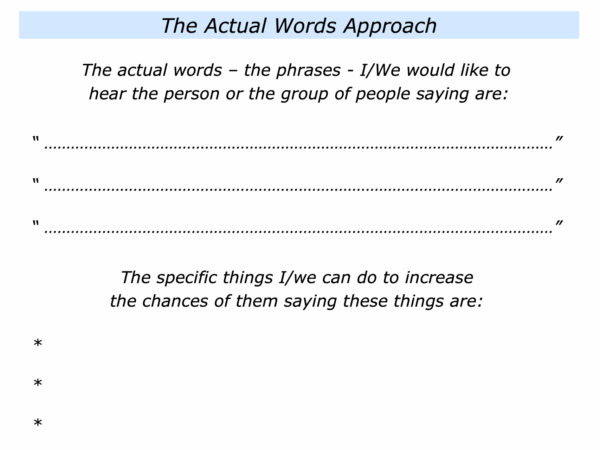
Imagine you are helping a team to set their goals. They may well focus on what they want to achieve in terms of profits, product quality and people’s wellbeing.
You can bring these goals to life by inviting them to do this well-known exercise. People go into groups and take the following steps.
They list each of the key stakeholders they want to satisfy – such as their bosses, the various customers, their colleagues and other stakeholders.
They describe the actual words they would like to hear each of these stakeholders saying about the work the team is delivering.
They describe the specific things they can do to increase the chances of them saying these things.
The team may want the customers, for example, to be saying the following things about the service it provides.
“They really understand our business … They deliver great service that helps us to achieve our goals … They act as one-stop shop for dealing with problems … They are true partners and help us to achieve success.”
The team may also want the leaders at headquarters saying the following things.
“The team always delivers its targets … It is self-managing, proactive and makes a good contribution to the business … It delivers great service to its internal customers … It produces people who go on to take important roles in the company.”
The next step is to describe the specific things they can do to increase the likelihood of the stakeholders saying these things and then translate these ideas into action plans. They then do their best to ensure people are saying these things.
This is an exercise I have used many times with individuals and teams. People describe what they want their stakeholders to be saying. They then aim to deliver this picture of success.
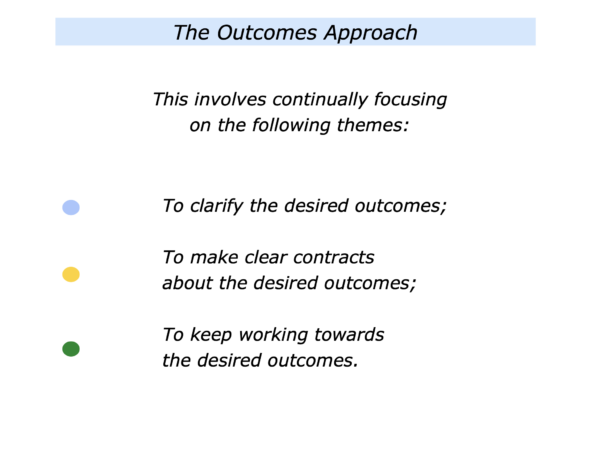
This approach mirrors some of the themes explored in the picture of success approach. It is included here become many people apply it in their daily lives and works.
The outcomes approach can be used in different situations. It can be used when setting personal goals, helping a person or working with a group of people. Let’s explore how this can work in practise.
Clarifying The Desired Outcomes
The approach starts by clarifying the outcomes to achieve. These can be on many levels – such as concrete, emotional and other outcomes. It can also be useful to clarify the benefits of achieving these results.
This involves starting from the destination. It calls from clarifying the real What – the real results to achieve – before moving on to the How. It then involves translating these into a clear picture of success.
The next step is to explore the How. It is to clarify the key strategies you can follow to achieve the goals. Sometimes you will do his by yourself, but on other occasions you will involve other people.
This will obviously be the case if you are helping an individual. You will create an environment in which they are able to clarify their aims. If appropriate, you can then help them to settle on their strategy for achieving the desired outcomes.
Great leadership teams often clarify the real results to achieve – the What – and the key aspects of the How. When appropriate, then then involve their people in building up the complete picture.
Whether you are setting personal goals or working with other people, it is vital to clarify the outcomes to achieve. You can then move on to the next stage.
Clear Contracting About
The Desired Outcomes
Good leaders often communicate the following things to their people. They start by giving them the big picture and context. They then explain:
The specific outcomes to achieve together with the benefits of achieving these outcomes;
The specific strategies for working towards achieving these outcomes;
The specific contributions that will be required to achieve these outcomes.
They always give the big picture and the reasons for the strategies. They also give people the chance to ask questions and, when appropriate, add their ideas.
Such leaders then give people the chance to reflect and decide if they want to contribute towards achieving the goals. If so, they again describe the outcomes to achieve. They then go through the following steps.
They make clear contracts with
each person – or each team – about:
The specific things they will deliver towards achieving the outcomes;
The specific support they will need to deliver their part of the outcomes;
The specific things they will do to proactively keep others informed about their progress towards delivering their part of the outcomes;
The specific early successes they will get on the way towards delivering their part of the outcomes.
Good leaders make sure that everybody knows what each person – or each department – is contributing towards achieving the goals. This helps to ensure that everybody is working towards the same picture of success.
Individuals sometimes make clear contracts with themselves. They may do this when working towards their personal or professional goals. Such people often go through the following steps.
They clarify the outcomes they want to achieve and the benefits of achieving these goals;
They clarify the specific things they can do to do their best to achieve these goals;
They clarify the pluses and minuses involved and, bearing these in mind, rate their motivation – on a scale 0-10 – to do what is required to reach the goals.
Such individuals make sure the rating is at least 7+/10. They then ask themselves the following questions.
“Am I really serious? Am I prepared to do what is required to reach the goals?”
They then decide if they really want to go for the goals. if so, they make a contract with themselves about the actual things they will do to do their best to achieve success.
Continually Working Towards
The Desired Outcomes
Great workers continually check that they are working towards the desired outcomes. They clarify what is working and what they can do better. They then keep following the disciplines required to achieve the goals.
Events sometimes occur that call for readjusting the goals. If so, people clarify what they can control. They then commit to achieving the new picture of success.
Good leaders also educate their people to continually focus on the desired outcomes. One leader I worked with did this when team members came to them to talk about challenges.
A person once asked him how to deal with a client that was causing problems. The leader said something along the following lines.
“Let’s go back to the outcomes we want to achieve. Do we still want to get wins for our company, wins for the customer and wins for our people? If so, what could that look like?
“What is the profit we want to make as a company? What is the quality of service we want to give to the customer? What are the feelings we want our staff to have? How can we do our best to achieve these outcomes?”
The leader and staff member clarified the real results to achieve. They then explored the possible options for going forwards – together with the pluses and minuses of each option.
Taking time to reflect, they considered if there were any other creative solutions. They then settled on the route they wanted to follow to do their best to achieve the picture of success.
There are many ways to use the outcomes approach, but it is worth repeating one key issue. The approach often calls for focusing on the more than the tangible results. It considering the emotional aspects.
Good decision makers take this approach. They clarify the actual things they want people to be feeling, saying and doing after reaching the goals. These outcomes form part of the desired picture of success.
The Second Empathy Approach
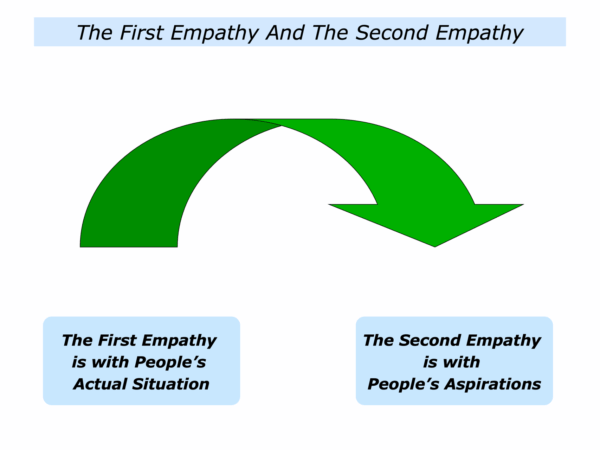
There are many views about the importance of empathy. Being this in mind, it can be useful to remember that there are different kinds of empathy. These can include the following.
The First Empathy
The first empathy involves having empathy with the person’s actual situation. This involves being able to, as far as possible, feel and experience the world from the other person’s point of view. It also involves checking to make sure you have the right understanding.
This kind of empathy is important but it can have both pluses and minuses. The pluses can include showing the person that you can, as far as possible, try understand their present situation.
The minuses can include a caring person getting caught up in the person’s present feelings. This can sometimes result in both people finding it difficult to move forwards in a positive way.
The Second Empathy
The second empathy involves having empathy with the person’s aspirations. It involves seeing the person’s abilities and the possible things they may be able to achieve in their life or work.
The next step can be to play back these ideas to see which resonate with the person. This is vital because, if a person believes something in their gut, they are more likely to achieve similar things in the future.
The second empathy involves being good at watching a person or learning about their positive history. When looking at a person, this includes being able:
To focus on their personal strengths – such as when they do superb work or follow their successful patterns;
To focus on their positive history – such as what they did right and the principles they followed to achieve things in the past.
To focus on what gives them positive energy – such as when they are following their passions and may be able to achieve peak performance.
Different people apply the second empathy in different ways to help others to achieve their goal.
As mentioned above, one approach is to focus on when a person has used their strengths or followed their successful style – even if it only for a few seconds. It is then to extrapolate this information to explore what the person can do or become in the future.
This involves using the organic approach to development. It is to focus on examples of when a person has done fine work. It is then to show how it may be possible for them to follow these principles to shape their future.
People have to believe in their guts. If they have done something before, they are more likely to believe they can do it again. They can follow similar principles – plus add other skills – to succeed in the future.
Good mentors, for example, often use both the first and second empathy. Whilst being able to understand a person’s actual situation, this also calls for being able:
To focus on a person’s abilities and connect with their aspirations … To clarify what the person want to achieve … To help the person to achieve positive results.
Good mentors invite a person to talk about their aims. If appropriate, they also share what they believe the person can achieve. They may say something along the following lines.
“As far as I understand it, the things you want to achieve are … Is that right? Let me ask you a question. Would you also like:
1) To …
2) To …
3) To …
“The reason I ask this is because, from what I know about you, I believe you could achieve these aims.
“It would involve you setting certain goals and doing the work. But I believe that you have the ability to achieve these goals. What do you think?”
This seems an enormous leap but I have seen it taken by many great counsellors, educators and mentors. Such people then help the person to clarify their goals and work towards their picture of success.
People who use the second empathy approach are often good at understanding the challenges that different individuals may face. They often have a background of learning about what is happening in different worlds.
Such people gather information in a neutral way without rushing to judgement. They like to understand: a) the challenges that people face; b) the potential solutions; c) the things that people can do to achieve success in these worlds.
They often have a pattern of being curious since childhood. They may have read extensively, watched films, visited various countries or done other things that widened their horizons.
This is a quality often shown by good therapists, educators, interviewers, trusted advisors and people in other fields. It helps them to understand other people’s situations and help them to manage challenges.
The following pages provide an introduction to what such people do when using both the first and second empathy. You will, of course, have your own approach to focusing on a person’s actual situation, abilities and aspirations.
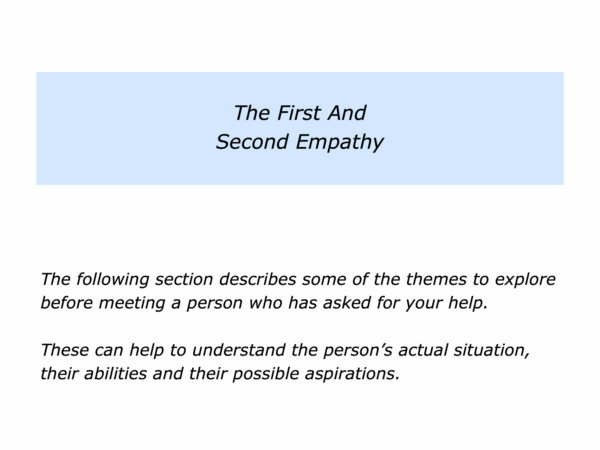
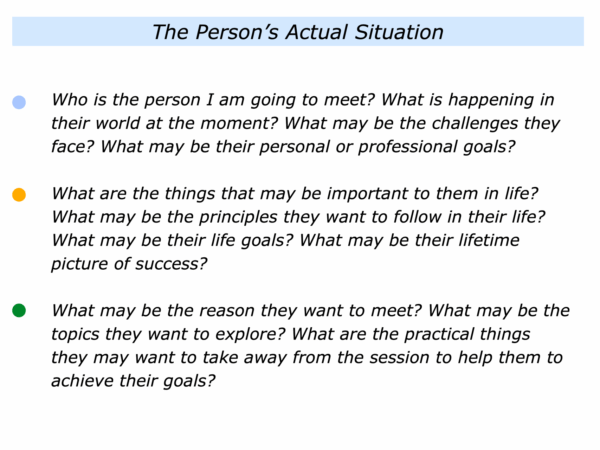
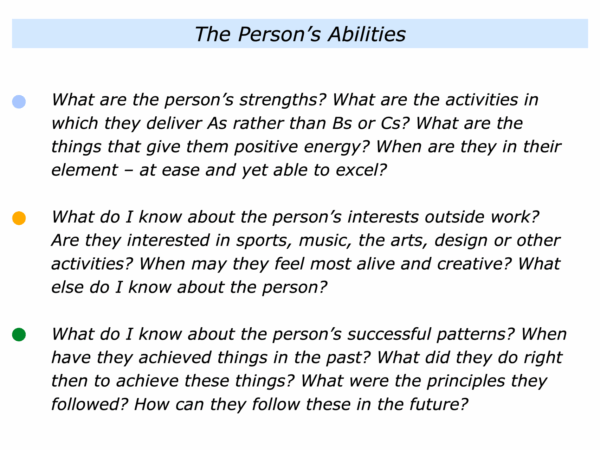
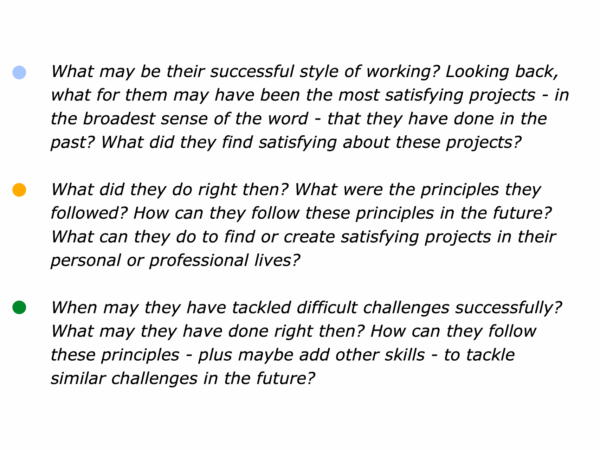
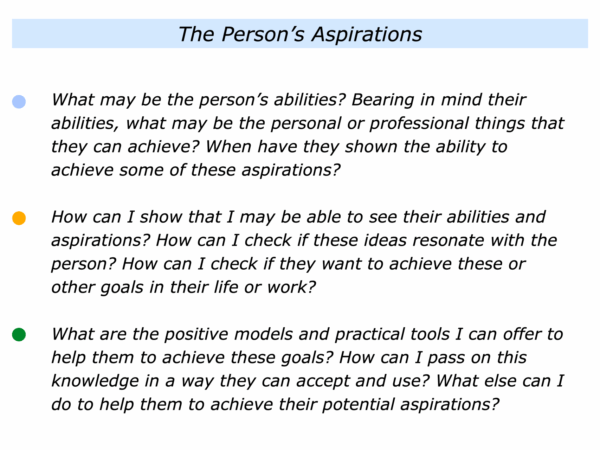
Let’s return to your own life and work. Looking ahead, can you think of a situation where you may want to follow elements of the second empathy approach? This could be in your personal or professional life.
How can you start by showing that, as far as possible, you understand the person’s actual situation? How can you then focus on their abilities and the possible things they could achieve in the future?
How can share what you believe may be their abilities and what they can achieve? How can you check if any of these resonate? How can you then clarify and, if appropriate, help them to achieve their personal or professional aspirations?
If you wish, try tackling the exercise on this theme. This invites you to complete the following sentences.
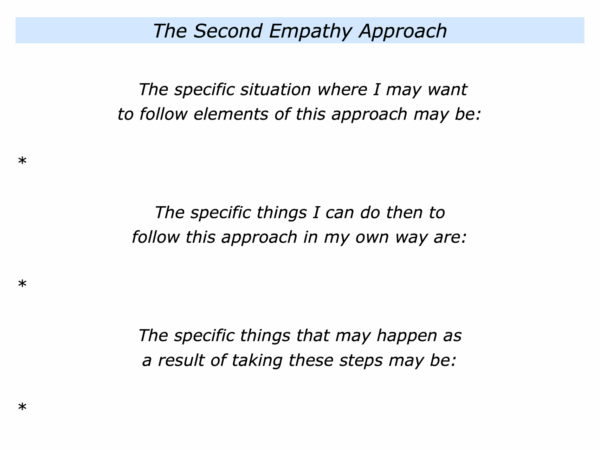
The Flip Questions Approach
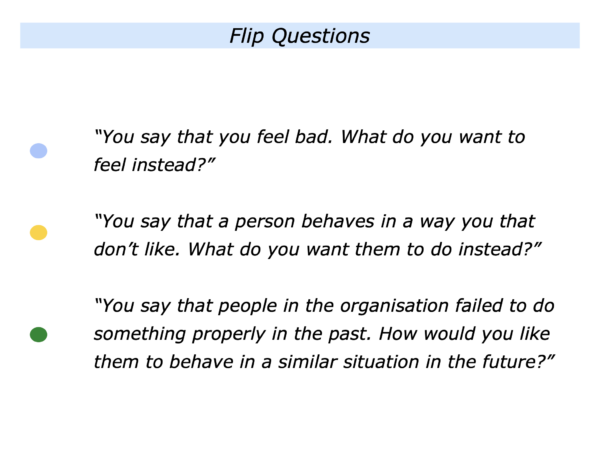
This approach encourages people to channel their energies in a positive way. It can be used in situations where an individual or a group express themselves in a negative way. They may be saying:
“I don’t like it when x does y … I can’t understand why they behave in that way … The organisation is messing up again … etc.”
One approach is to just listen. If the person or the group keeps complaining, however, this may not help. Another approach is to ask Flip Questions.
These invite the person or the group to say what they would like to see the other party do instead. It is to say things like:
“What would you like to see happen? What do you want the person or organisation to do instead? What could they do to encourage you? What could they do to help you to achieve success?”
People who are complaining may resist this approach at first or may choose to stay in the negative spiral. They may also say there is little point in trying because the other party will not change.
Good mediators, for example, stay patient. They keep inviting people to say what they would like to see happen. They ask them:
To clarify what they would like the other party to do instead;
To clarify the specific things they can do to present these options in a positive way – including explaining the benefits to all parties;
To act as good models and do their best to achieve the picture of success.
Therapists also use flip questions. Whilst they may show empathy, they sometimes invite the person to channel their energy in a positive way. They may some of the following things to a person.
“You say that you feel bad. What do you want to feel instead?”
“You say that you want to stop feeling angry. What do you want to you want to feel instead?”
The therapist will help the person to clarify how they can do their best to achieve the positive results.
Looking back, can you think of a specific situation where you used elements of the flip questions approach? This could have been in your personal or professional life.
Depending on the situation, this may or may not have worked. Much depends on the other person or people involved.
What did you do then to use the flip questions approach? How did you try to encourage the person or group of people to channel their energy in a positive way? What happened as a result of taking these steps?
The Success Stories Approach
This is an approach that can be used to help individuals, teams, organisations and even societies to achieve success. It is based on the principle that:
People buy success rather than the theory of success.
People are more likely to change their behaviour if they can see what works and see the benefits. Let’s explore how this can work.
Helping people to learn
from their own successes
Imagine that a person or a group of people would like to tackle a challenge or achieve a specific goal. One approach is to invite them to learn from their own success stories. You can invite them:
To recall when they have tackled a similar issue in the past and achieved success;
To clarify what they did right then – the principles they followed and how they translated these into action – to achieve success;
To clarify how they can follow similar principles – plus maybe add other skills – to tackle their present issue and achieve success.
Helping people to develop by you doing
superb work and producing success stories
Imagine that you have been asked to do help people to succeed and maybe even shift a culture. You can try to get everybody in a system to change their behaviour. This seldom works, however, and can lead to frustration.
Another model is to take the success stories approach. This involves taking the following steps.
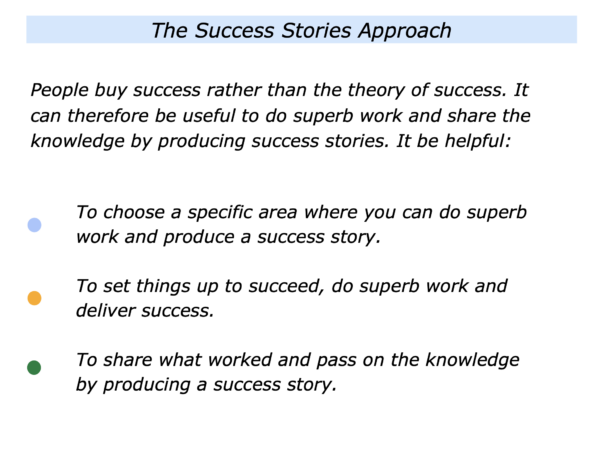
The first step is to focus on a specific area – such a topic, team, project or other activity. It is to choose one where, providing you do superb work, you stand a good chance of delivering success.
The second step is to focus on what you can control and set things up to succeed. It is then to get some early wins, do superb work and deliver success.
The third step is to pass on the knowledge by producing success stories. The aim is to show what works. It is then up to people to decide if they want to apply these principles in their own ways to achieve their picture of success.
There are many ways to help people to achieve their goals. One approach is to help them to work towards achieving their picture of success.
Looking ahead, can you think of situation where you may want to use elements of this approach? This could be in your personal or professional life.
You may want to encourage a person, support a team or enable an organisation to achieve its goals. How can you help them to clarify their picture of success? How can you then provide practical tools and help them to achieve positive results?
If you wish, try tackling the exercise on this theme. This invites you to complete the following sentences.
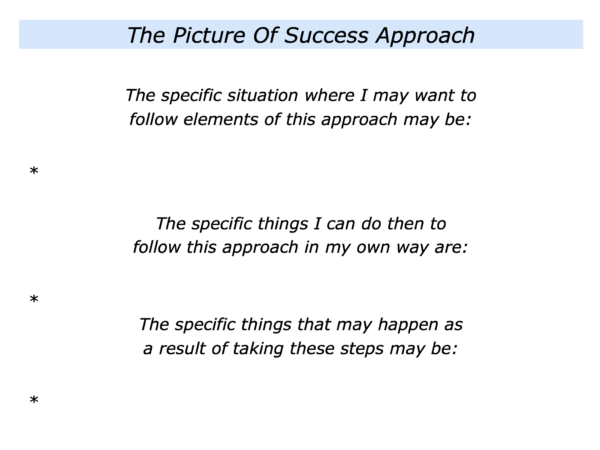


Develop yourself to succeed: The I CAN Approach